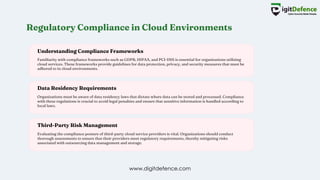Essentials of Network and Cloud Security.pptx.pdf
- 1. Essentials of Network and Cloud Security www.digitdefence.com
- 2. Understanding Cloud Security Cloud security refers to the set of policies, technologies, and controls deployed to protect data, applications, and infrastructure associated with cloud computing. Its importance lies in safeguarding sensitive information from unauthorized access, ensuring compliance with regulations, and maintaining the integrity and availability of services. As organizations increasingly rely on cloud solutions, robust cloud security measures are essential to mitigate risks and protect against evolving cyber threats. www.digitdefence.com
- 3. Core Requirements for Data Protection 01 02 03 Data Encryption Standards Access Control Mechanisms Regular Compliance Audits Implementing strong encryption protocols is essential for protecting sensitive data both at rest and in transit. This ensures that unauthorized users cannot access or decipher the information, thereby maintaining confidentiality and integrity across cloud environments. Establishing robust access control measures, such as role-based access control (RBAC) and multi-factor authentication (MFA), is critical. These mechanisms help to limit data access to authorized personnel only, reducing the risk of data breaches and insider threats. Conducting regular audits to ensure compliance with relevant data protection regulations (e.g., GDPR, HIPAA) is vital. This not only helps organizations identify vulnerabilities but also demonstrates accountability and commitment to safeguarding personal and sensitive information. www.digitdefence.com
- 4. Regulatory Compliance in Cloud Environments Understanding Compliance Frameworks Data Residency Requirements Third-Party Risk Management Familiarity with compliance frameworks such as GDPR, HIPAA, and PCI-DSS is essential for organizations utilizing cloud services. These frameworks provide guidelines for data protection, privacy, and security measures that must be adhered to in cloud environments. Organizations must be aware of data residency laws that dictate where data can be stored and processed. Compliance with these regulations is crucial to avoid legal penalties and ensure that sensitive information is handled according to local laws. Evaluating the compliance posture of third-party cloud service providers is vital. Organizations should conduct thorough assessments to ensure that their providers meet regulatory requirements, thereby mitigating risks associated with outsourcing data management and storage. www.digitdefence.com
- 5. Access Management Strategies 01 02 03 Role-Based Access Control (RBAC) Multi-Factor Authentication (MFA) Regular Access Reviews Implementing RBAC allows organizations to assign permissions based on user roles, ensuring that individuals have access only to the information necessary for their job functions. This minimizes the risk of unauthorized access and enhances security management. Utilizing MFA adds an extra layer of security by requiring users to provide two or more verification factors before gaining access. This significantly reduces the likelihood of unauthorized access, even if credentials are compromised. Conducting periodic reviews of user access rights is essential for maintaining security. These reviews help identify and revoke unnecessary permissions, ensuring that only authorized personnel retain access to sensitive data and resources. www.digitdefence.com
- 6. Identity and Access Management (IAM) is crucial for ensuring that the right individuals have appropriate access to technology resources. It encompasses user identity verification, role assignment, and access control policies, which collectively help mitigate security risks associated with unauthorized access in cloud environments. Fundamental IAM Concepts Implementing best practices such as least privilege access, regular audits of user permissions, and integration of automated IAM solutions can significantly enhance security. These practices ensure that users only have access necessary for their roles, reducing the potential attack surface and improving overall compliance with security standards. IAM Best Practices Identity and Access Management (IAM www.digitdefence.com
- 7. Data Encryption Techniques Symmetric vs. Asymmetric Encryption Encryption Protocols in Use Importance of Key Management Symmetric encryption uses a single key for both encryption and decryption, making it faster but less secure if the key is compromised. Asymmetric encryption employs a pair of keys, enhancing security by allowing public key distribution while keeping the private key confidential. Common encryption protocols such as AES (Advanced Encryption Standard) and RSA (Rivest-Shamir- Adleman) are widely adopted for securing data. AES is favored for its speed and efficiency in encrypting large volumes of data, while RSA is often used for secure key exchange and digital signatures. Effective key management practices are critical to maintaining the security of encrypted data. This includes generating strong keys, securely storing them, and implementing regular key rotation to minimize the risk of unauthorized access and data breaches. www.digitdefence.com
- 8. Network Segmentation and Its Benefits Pros Cons Enhanced security posture limits lateral movement improved performance reduces congestion easier compliance management isolates sensitive data Increased complexity higher implementation costs potential for misconfiguration requires ongoing management may hinder communication training needs for staff www.digitdefence.com
- 9. Implementing Firewalls and Intrusion Detection Systems Properly configuring firewalls is critical for establishing a secure perimeter around network resources; this includes defining rules for traffic filtering, implementing stateful inspection, and regularly updating firewall policies to adapt to emerging threats and vulnerabilities. www.digitdefence.com
- 10. Preparing for Future Security Challenges 01 02 03 Anticipating Emerging Threats Integrating Advanced Technologies Continuous Training and Awareness Organizations must stay ahead of evolving cyber threats by continuously monitoring trends and adapting security strategies. This proactive approach involves investing in threat intelligence and understanding the tactics used by cybercriminals to better prepare defenses. Leveraging advanced technologies such as artificial intelligence and machine learning can enhance security measures. These technologies enable automated threat detection, real-time response capabilities, and improved risk assessment, making it easier to address future security challenges effectively. Regular training programs for employees on security best practices are essential. By fostering a culture of security awareness, organizations can reduce human error, which is often a significant factor in security breaches, thereby strengthening their overall security posture. www.digitdefence.com









